
The Nomad is a series of stories, fascinations, encounters, observations, experiences, joy of the moments by me, Ulrike Reinhard – all around my travels. Stay tuned!
Ulrike Reinhard is The Nomad 🙂
This is my humble attempt to describe how a reportage around Stephan Brückner and Wolwedans in Namibia took its very own way. I am writing this because I felt the process how this happened was almost flawless – and this might be a good example for young story hunters on how to get what you want and even a little bit more 🙂
I am writing this before I’ve finished the actual story because this process is for me even more important than the reportage itself.
Why this reportage ?
I heard about Stephan and Wolwedans for the first time – I think – through a Deutsche Welle documentary on Namibia. Together with his father Albi Brückner, Stephan started the Wolwedans Lodges in 1995. A business endevour in a private conservation area. Nothing new so far. What made it different was his approach. As an integral part of his business he has implemented a far reaching social/community/ecological and economic project which he calls Rural Revive. It is a serious effort to revive the hard hid rural economy in Maltahoehe, a village in the middle of nowhere, and this effort is driven by going the extra mile in his business endevour. This is what caught my attention – because such an effort is
- very close to my heart – we follow a very similar approach in Janwaar
- very important for rural communities in general (can be used as a blueprint) and
- a different way to run a tourism business.
I wanted to know more and see who this person is and how seriously he is walking his talk! Does he follow his well writen corporate values (5C’s – commerce, community, culture, conservation, consciousness and 3P’s – people, planet, profit) – or is it simply advertising slang? Very often – at least in my experience – well written words differ quite a bit from the business practices and this is where the wheat is separated from the chaff.
After some emails back and forth we agreed to meet in Windhoek and Stephan offered me to drive with him to Wolwedans. From Windhoek we went via Marienthal to Maltahoehe (this is where the tar road ends) and then onwards to Wolwedans, roughly 530 km in total.
BTW Wolwedans is an Afrikaan word and means where the wolves are dancing.
Remark: Just to be clear – the following essay (or however you want to call it) focuses on the development of the story, how I got the information I wanted – it is not an article on the topic which I mentioned above. This here is broader – it has some overlaps, yet a different focus! Please keep this in mind while reading! Thank you!
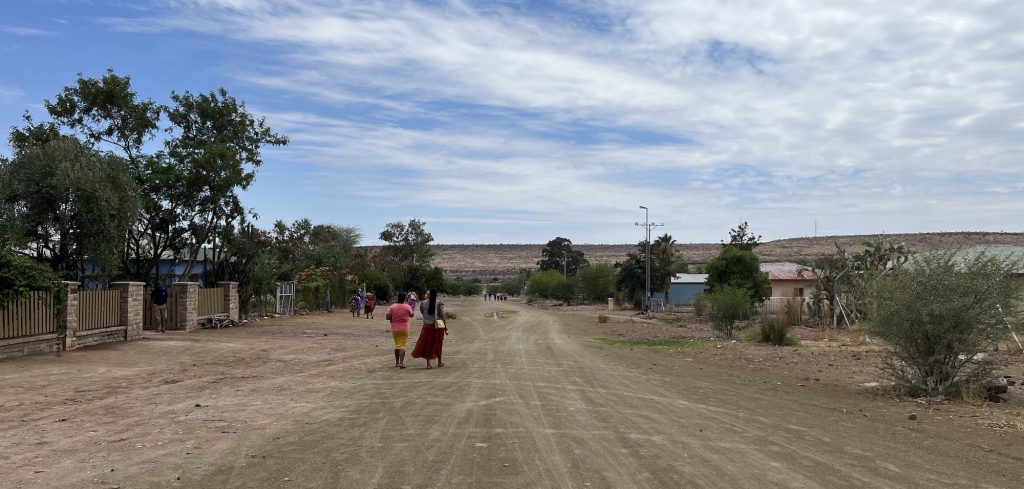
A brief summary upfront
After I understood how busy Stephan would be during my stay and after our first conversations in the car, I decided to go with the flow and trusted that “my time” would come. I didn’t push for any interview time or requested anything (meaning I put my ego aside 🙂 ), I participated as much as I could in the ongoing events and I “waited” for the moments when he was ready to talk. And these moments would come on a daily basis – on drives throughout the Wolwedans property or over a glass of wine or two at sundowner/dinner time. Sometimes it happened in the presence of Wolwedans guests or business partner or staff. Sometimes it was only the two of us. So I was able to experience him “wearing his different hats”: host, business man, boss. This gave him comfort, didn’t disturb his daily routine and work and gave me time to look around and talk to people who were actively involved in the community and the business. A win-win-situation.
At the end I had hours of conversations with him and the people involved, I had a variety of very different experiences and I had details, I had time to “download” the place which is crucial for the reportage and I didn’t had to bother Stephan. The collection / gathering of information happened in single pieces and the entire picture emerged in its very own way and time.
And maybe as a side note – I didn’t record any of our conversations, sometimes I took notes in the evening or next morning. The only recordings I did were with two employees – Adrian the horticulture guy and Kaina, the waste manager.
What was key? I was open, present, able to put my ego aside and I trusted the process.
The longer version
The longer version is structured according to the route we took and places we stopped.
1. Windhoek
Stephan picked me up at the Prestige Cafe in Windhoek. It was close to the place where I stayed and I used it as “my office”; a lovely place to spent time, delicious cafe and even better cakes 🙂 And to my surprise hardly ever any people. I was working when he arrived. I packed my small black backpack and off we went in a beige Landrover.
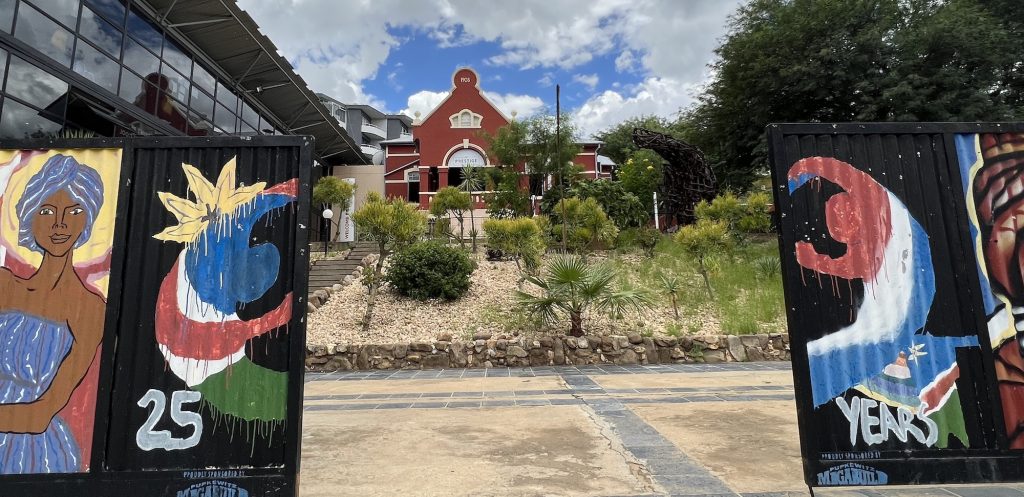
I got a little tour through WIndhoek because he needed to organise some things. Hands on! It seemed he had a lot on his bucket list but patiently and steadily he got it done. We went to the construction site of his new house, we tried to find some colour for painting – and I learned, that if you want to get things done in Namibia, you always have to double check and follow up. This sounded very much familiar – India, can you hear me 🙂
At our last stop we picked up another Stefan – a Stefan with a “f”. Stefan is working as a consultant for Stephan, supporting him on the value C=CULTURE in the Wolwedans/Rural Revive set-up.
2. Windhoek >>> Marienthal
The distance between Windhoek and Marienthal is 280 km, a good 3 hour drive. Besides one little detour into a farm on the roadside to check if there is water in the dam, we went straight to Marienthal. And the three of us were talking all the time – the warm-up session so to speak.
Stephan asked me about my intentions and what the focus of the reportage would be and I gave them in addition a bit of background information about myself. I explained why I only have “light” luggage and that I am literally a nomad, that I don’t have a home to stay and zero fix costs. I was making my way through the world with writing and interview jobs and every now and then I would give a talk. This is giving me enough to keep on going. Stephan thought that was rather “radical”. I told them how I learned about their work and what I was planning to focus on.
I listened to what they had to say about the Desert Runner, their waste and laundry project, and the vocational training program. We were discussing the 5 C’s of the Wolwedans’ value system: Community, Commerce, Conservation, Culture and since 2020 Consciousness and the balance of their 3P’s: People; Planet and Profit. I heard about the AridEden Project. We spoke about the urgent need to run commercial businesses in a much more ecofriendly and sustainable way. I shared details from my project in India and I realized there were quite some similarities. We disucssed economic concepts which might support this transition from pure commerce and profit to community-based and more eco-friendly approaches. Stefan with “f” pulled out a book by Bruno Latour and Nikolat Schultz: Zur Entstehung einer ökologischen Klasse (The emergence of an ecological class), a manifesto for the desperate need for an ecological class to stop climate change – just as the working class once fought for social progress. A very interesting book, I flipped through later in the evening. I shared Johan Rockström’s work on “A safe operating space for humanity” in combination with the economic Donaught Model from Kate Raworth …
It was a give and take, not me, me, me. There was the sense of meaningful purpose and urgency. It was a lot of information, a lot of details in no specific order or frameset. These Stef(ph)ans were thinkers and their concern about the planet and their commitment to drive change was honest and real – I felt I was within my tribe 🙂
3. Marienthal >>> Malthahoehe
At Marienthal we met more team members of Rural Rivive. Two media guys, Lucky and Warren, who were documenting the Rural Revive journey and Reinhold, the link between Rural Revive and Wolwedans Foundation. Stefan with “f” switched cars and with us was now Adrian.
Adrian had just finished his agriculture studies in Stellenbosch, South Africa, and started working at Wolwedans. In the team he is responsible for capacity building in horticulture – in other words his job is to turn parts of the deserts into green gardens. Adrian had already spent six weeks before Christmas at Wolwedans and was now looking forward to take horticulture to the next level. He is a very conscious young man and shares Stephan’s vision with Rural Revive. He knows what he is good at and he knows exactly what he can contribute – I found this quite remarkable for a young man of his age. There was a deep trust between Stephan and him.
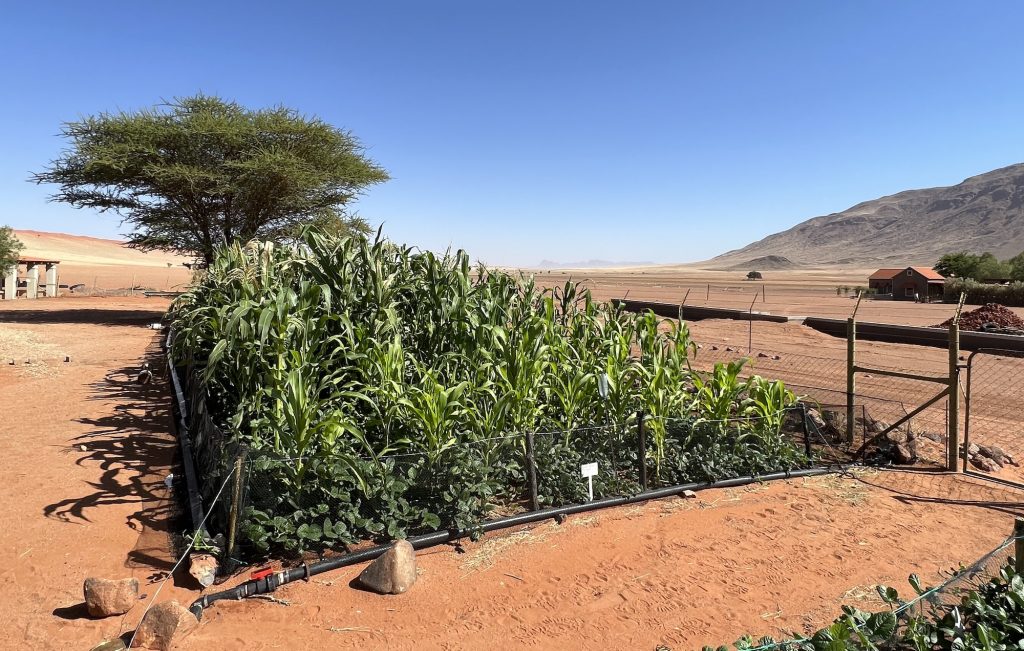
On this segment of our journey I learned about Rural Revive’s horticulture plans. I knew they had a green house and were experimenting on various levels; now I understood that at Maltahoehe they were training local farmers in organic farming, they do this with their trainees at Wolwedans as well and the idea is to have enough agriculture land or green houses to produce enough organic food for all employers and guests of Wolwedans and in a next step to open a barn, take in the organic food from the local farmers and sell it to the other lodges in the desert.
There is quite a market in this desert for which Maltahoehe – our final destination for the day – is the gateway. 1400 hotel beds in total and probably the same number of staff – and all of these people need food. Currently the food is coming mainly from South Africa, it’s brought to Windhoek and from there distributed to the lodges, of course NOT in a coordinated way. So if this horticulture part of Rural Revive would work, it would reduce the amount of km the food is travelling until it reaches a lodge tremendously and it would increase the quality of food. And on top it would provide income for the locals in Maltahoehe.
Two hours later we arrived at Maltahoehe, a village – est. 6000 people are living here. It was once well-known for its Karakul sheeps, but since decades it’s economy is in constant decline. There is no retail shop, no businesses – unemployment is skyrocketing! This is the location of Rural Revive. Maltahoehe definitely needs a revival.
When we entered the village, Stephan stopped the car. There was a HUGE AMOUNT of trash at the side of the road – plastic, plastic, plastic and some cows behind a fence probably eating it! It was disgusting – yet reality!
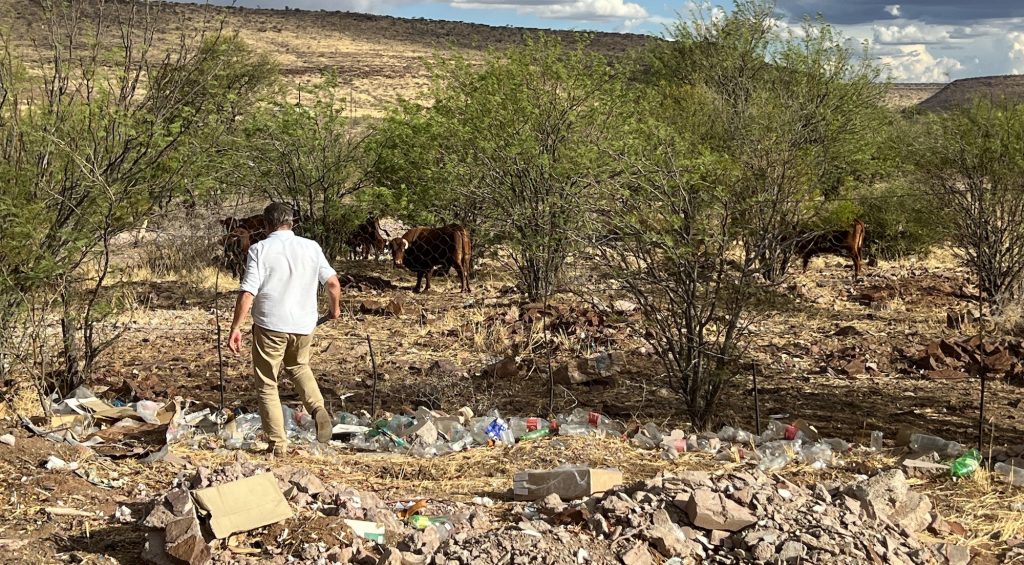
Trash/waste is another huge topic Rural Revive is addressing, yet not first on the agenda. This has to wait until next year! We immediately went to Rural Revive Center or hub, platform, framework or whatever you want to call it. I heard all names. All of a sudden the different projects and components I had heard about in bits and pieces became tangible. I saw the infrastructure which was built over the last year in order to put the theory into action and I finally learned that the event next morning would be the first birthday celebration of Rural Revive.
Only now the reason why we were here was finally clear to me as well 🙂 Sometimes it just takes longer!
I got my first quick tour around the campus – I saw the green house, the laundry, the water recycling apparatus, the garden, the training center – and I would hear from the people around that finally something was happening in Maltahoehe after all these years. We went to the hotel, which is run by Marika and is probably the only business which is somehow functioning at Maltahoehe. Marika is a great spirit for Rural Revive and the village. She knows all the locals, they come to her hotel restaurant, she understands how they tick and how important it is for the people to be proud again of their village. It’s about dignity, she said. She is member of the steering commitee of Rural Revive and a strong positive force for change. She is the kind of “Big Mama” in the community! We had dinner at her place (I had a German Bratwurst) and then – with my full stomach – honestly, I was ready for a rest.
My first day with Stephan and his team was over – I had already tons of valuable material from various sources without putting the reportage in the center. The tone was set – I felt this is the way to go. Engage, become a part of what is happening and don’t push.
The next morning was the BIG DAY; the first anniversairy of Rural Revive – they would open their doors for the public. The day started with a circle time at 7 am – the entire team came together to talk the event through and make some last minute arrangements. The stage was set and excitement was in the air. They were ready to go!
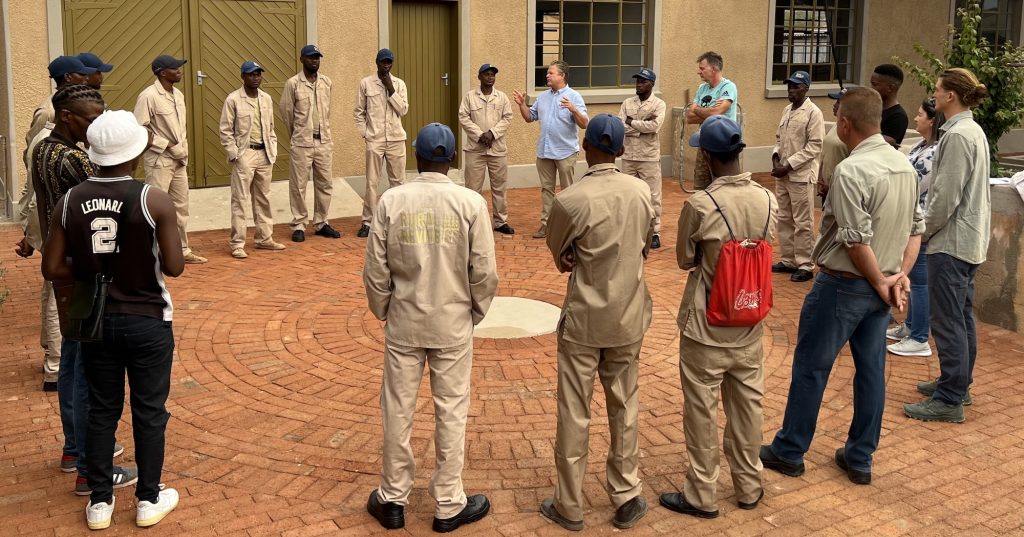
The show began at 10 am and went on for two hours. The house was packed, many people were standing outside; I’d guess 120-150 people attended, most of them from the community and most of them women! And of course some officials from the municipality and district. The two official ladies were supposed to plant trees. For some reason the trees from the nursery at Wolwedans hadn’t arrived. So I had taken my chance in Marienthal where we bought new trees and sponsored the two little trees they were planting – it gave me a nice feeling during the ceremony!
It was a colourful gathering – African colours on parade!
The program was designed by the local staff, Stephan didn’t intervene in the planning process and when he asked what his role in the program was, Marika replied: “I don’t think you are a part of the program!” And she meant it. I really had to laugh. Stephan took it easy yet, he seemed to be a bit surprised 🙂 At the end, he wrapped up the official part of the celebration and invited the people to tour the campus.
The team presented their achievements of the first year and laid out the plan for 2023. They are operating in these fields:

The infrastructure for the laundry is up and ready to go. The water of the washing machines will be cleaned and used to water the horticulture, the filterplant is there and the tanks are waiting to be filled. The first green house for organic vegetables is built and you can see a green carpet when you look in there. Also the outdoor garden is producing its first vegetables. Bigger green houses in the back of the campus are planned. Lydia, a young lady from nothern Namibia, is training some students in horticulture and is walking around in the village, to inform the farmers about the new possibilities. She was so happy to see that some of them showed up for the birthday party – her work was rewarded! A small barn is there where all kind of local products can be brought for sale and a bigger barn, two blocks down the road, is already bought and is meant to serve as a local market in the not so far future. And then there is the Desert Runner (I love this name), which will run between Marienthal, Maltahoehe and the desert should be in place by mid 2023 – it will transport the vegetables, laundry and the waste – and if someone needs a lift to or from the desert, they can hop on for 99 NAD. The Desert Runner will be crucial for the economic success of the entire project.
The investment until stage 3 which includes all the infrastructure so far including the desert runner is 700.000 Euro – this money is invested by the Wolwedans Foundation. and it has already created 20 or more jobs – mainly for people at Maltahoehe. Piet, the new manager of the place, is a retired industry man who has returned to his home village. He was born and raised in Maltahoehe and as a devout Christian, he wants to give back to the community now. He is currently busy to figure out all the logistics, to get all the necessary paper work/certificates/compliances done and to implement what is needed to get the campus off the ground. And inbetween he needs a “decent smoke” – he will step aside, stuff his pipe and enjoy the tobacco.
It became obvious to me that the theoratical concept of Rural Revive is turned into practice. Implementation is happening. This year will be crucial for its success.
The entire event went well, the community followed the invitation and there was hope in the air. It was well received. Finally something new and promising was happening in Maltahoehe – and the locals were involved on multiple levels.
The event was precious for me because I was now able to connect all the dots which I heard about on our trip. I had theory and practice, I met employers, management and partners.
4. Maltahoehe >>> Wolwedans
After a well deserved post-event nap, we left Maltahoehe in the late afternoon for Wolwedans.
The tar road ended in Maltahoehe and we were now on gravel road for the next 150 km until we would reach Wolwedans. While we were driving through insanely beautiful landscape – a friend of mine described it as a perfect, completely undisturbed cosmic order – we were reflecting on the event in the morning …
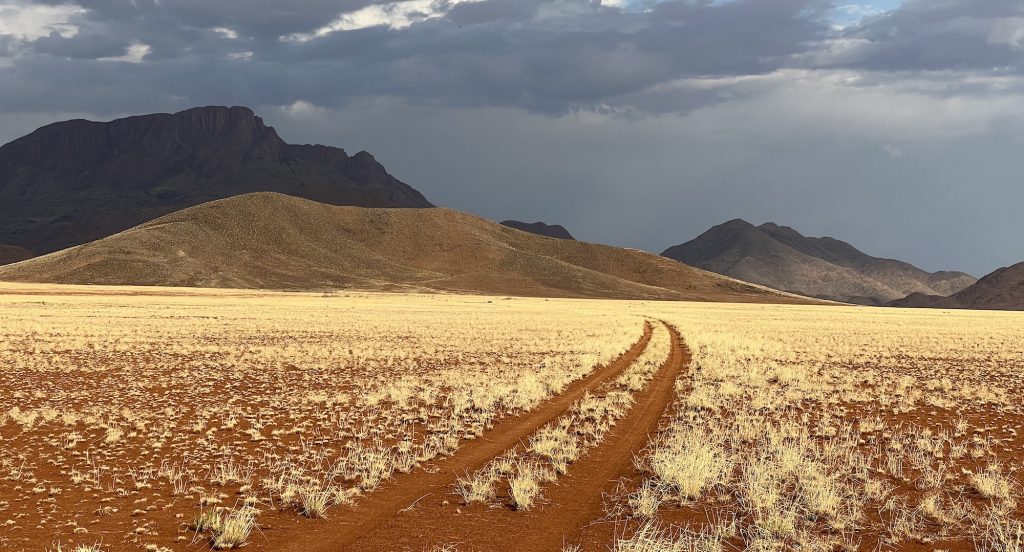
Over and over again Stephan would start “Weißt du …. ” (You know ….) and he would dig deeper and deeper into the single projects of Rural Revive, letting his thoughts flow and trying to explain everything from different angles. I felt like his sparring partner and developped a deeper understanding of the project and Stephan’s thought processes.
Another of the 5 Wolwedans’ C’s, the C=CONSERVATION came to the forefront on this part of the journey. Stephan is deeply involved in enlarging the conservation area in the NamibRand Nature Reserve. It includes an area of more than 200,000 ha already. Together with friends and partners he wants every fence to fall that the animals can roam their habitat unhindered. It is already a big accomplishment what they have achievd – yet the goal is more. On our way down to Wolwedans one single car crossed our way, and that was a neighbouring farmer. You are alone in this landscape – a very exclusive and luxurious feeling. I really cherished this during my time at Wolwedans.
Stephan also provided insights into his personal struggles. It became obvious that his heart is beating much more for the C=CONSERVATION and C=COMMUNITY than for the C=COMMERCE, meaning the lodges. He is fully aware that without the COMMERCE the other C’s would vanish – so he needs to get the lodges fully up and running again after a long tough COVID breakdown. Which is indeed a challenge of its own. No cash flow, re-recruiting staff, less tourists ….. It is a fine line between ecological sustainability and business demands and every now and then conflict arises. And he is struggling with this – asking himself how far can I push the envelope and sometimes he put in in one line: “Sometimes I have to be a hooker!”
Meanwhile I was no longer surprised by Stephan’s openess and willingness to talk. There seemed to be no boundaries and restrictions. The doors were wide open. I highly appreciated this. And on top of all – honestly there is no better guy to drive down this road. Maybe Stephan’s father would have been, but he died a couple of years ago. Stephan knows every tree, house, piece of land along the way – and for all of this he surely has a story to tell.
5. At Wolwedans
We made it into Wolwedans just on time for the sunset. At Plains Camp, one of the four Wolwedans lodges, two business ladies, Michelle and Linda, were waiting for Stephan. They’d arrived a few days earlier; they are in the tourism industry and help Stephan to market the lodges and advise him in interior design and customer services. Their perspective is customer experience! And no compromises on that! Everything needs to exceed the expectations of the guest. They are selling dreams, comfort, exclusivity – not social reponsibility. A different angle and perspective on the same issue. And a very valid one!
Stephan was fully aware and admitted that the lodges were not up to the perfect pre-COVID standards, maybe up to 90% – and he knew that the ladies were here to get the missing 10. And to arrive there Stephan knew he would have to make compromises … or to make cuts with a certain kind of clientle, but this is not easy. It is a conflict – being somehow rebellious in this upscale market segment can easily turn down the economic spiral.
The ladies had experienced a desert thunderstorm first hand and were cleaning up the lounge area when we arrived. It was – according to Stephan – a good experience for them to have because now they understand better what the challenges are in a location like this. Besides COVID, getting the right people and so on. The water ran into the tents and the carpet got wet … Does the carpet need to be replaced or can it just dry out – that’s just one of the questions which needs an answer in this high end market segment ….. ? I was surprised …
Over my first sundowner at Wolwedans I listened to their conversation – my first intro to the tourism industry. It was an eye-opener; and surely a completely different story to what I’d witnessed in Maltahoehe with Rural Revive. Here it was tough business talk. Market segments, services, consumer experience, margins …. you name it.
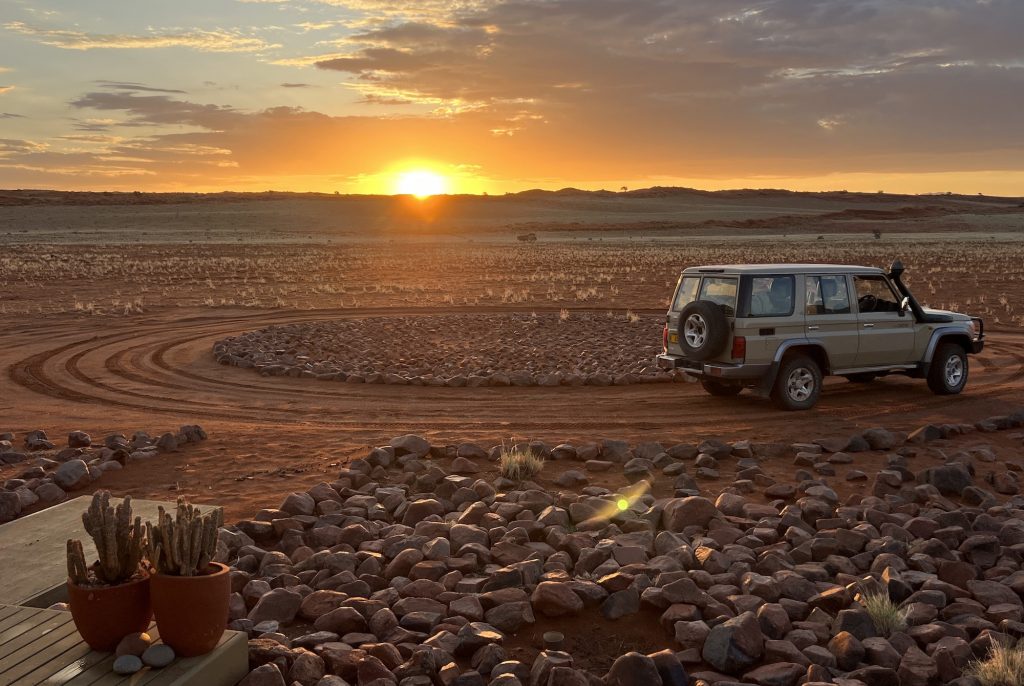
After the sundowner – it was already pitch dark – we drove another 20 minutes up to the Dunes Camp where I would stay for two nights as a guest – customer experience 🙂
We sat down at the camp fire for another glass of wine and met two guests. We shared the dinner table. They surely thought in the beginning we were a “new arrival”. During the dinner conversation it clicked and they realized that Stephan was the owner of the place. We chatted about the aftermath of COVID on Wolwedans and how difficult it is – without the “normal” cash flow – to restart such a business and lift it up again to the old standards which are required and expected from the guests. It became obvious to me that a guest who pays the expensive lodge doesn’t care much about the owners struggles to overcome COVID – they demand immaculate service and comfort. They are not willing – in this case – to carry the shampoo from the indoor to the outdoor shower, they expect another shampoo to be there. Period.
The couple showed interest in the activities of the Wolwedans Foundation, yet when I asked them the following day if this would have an impact on their decision to choose Wolwedans as their destination, they clearly stated no. In contrary, they said: “We are a bit concerned that all these activities take their toll on the comfort and services at the lodge!”
…
The next day and a half I was guest. I went for a walk with the bushman (a descendent of the nomads who used to live in this area), enjoyed a beautiful scenic drive over the property and felt home in my “tent”. The second night I slept outside on the deck on one of the sunbeds – just to be literally under the stars. I “downloaded” the place.
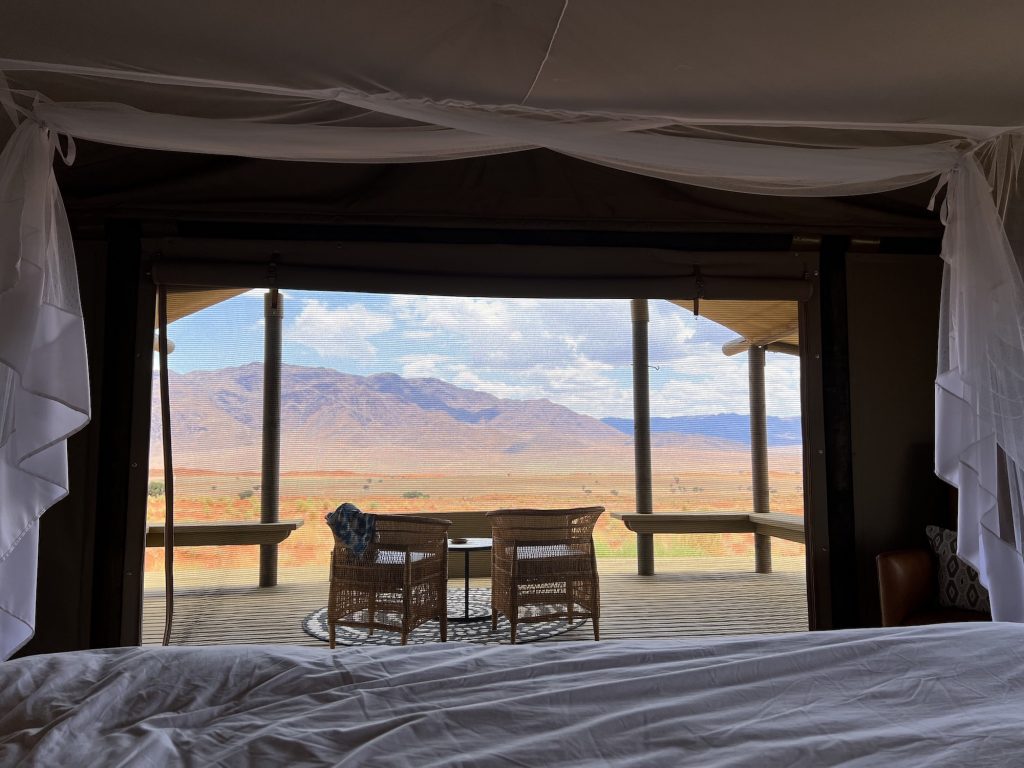
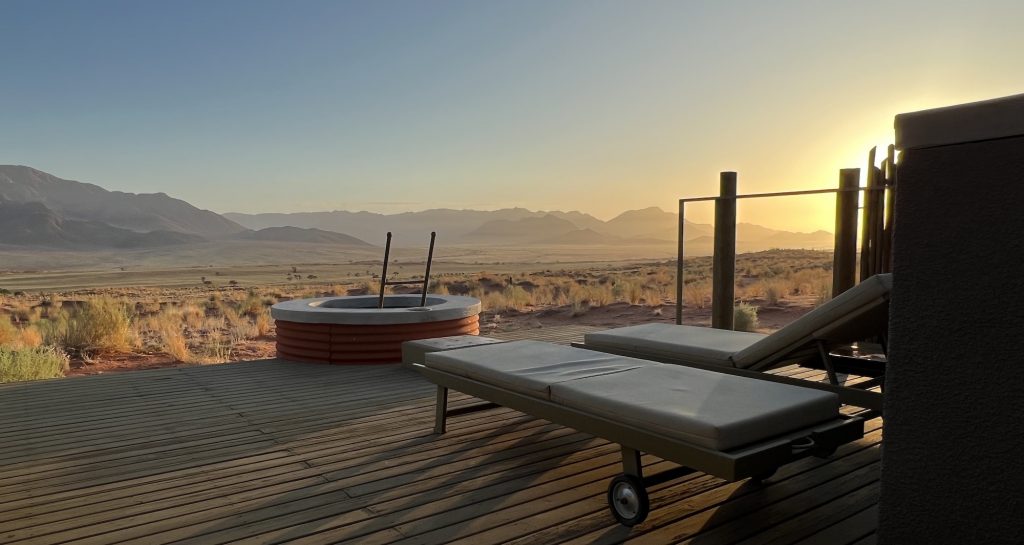
Where I slept the second night
From the Dunes Camp I moved down to The Village, the heart of Wolwedans. The Village is the place where the reception is, all the staff is living, administration, guest houses and so much more. It is the place where most of the fix costs at Wolwedans are “produced” – and it was a pleasant suprise to see how comfortable the staff is living here. You won’t find this in many lodges.
I had another five days and I was looking forward to experience “village” live and first hand how the 5C’s and the 3 P’s (profit, planet and people) were practiced and balanced out. Again no restrictions in place – I was able to talk to everyone. I could simply become a part of it!
Just like at Maltahoehe the day in The Village starts with circle time – at 7am all staff would be at the amphitheatre. One employee would take the lead and guide through the circle time. Stephan introduced me to the team so that everyone knew why I was here. The circle time is bringing everyone together, they start the day together, they read a theme out of their company compass and make necessary announcements. They include a people count – they are now back to roughly 70 employees, pre-COVID they were 130. At the end one employee is suggesting any kind of group game – which is often quite funny. Then everyone is starting with their jobs.
Besides the job there is not much to do for the employees – you can’t quickly go to the city to buy something or go out for a drink with your friends. You are literally stuck at the place. Usually they stay for six weeks and then go home for two weeks. I can imagine for some people this is quite a challenge – Adrian, the horticulture guy, admitted, that this is what he is missing most, a beer with his friends in the evening. Also Stephan said that sometimes it gets pretty lonely there.
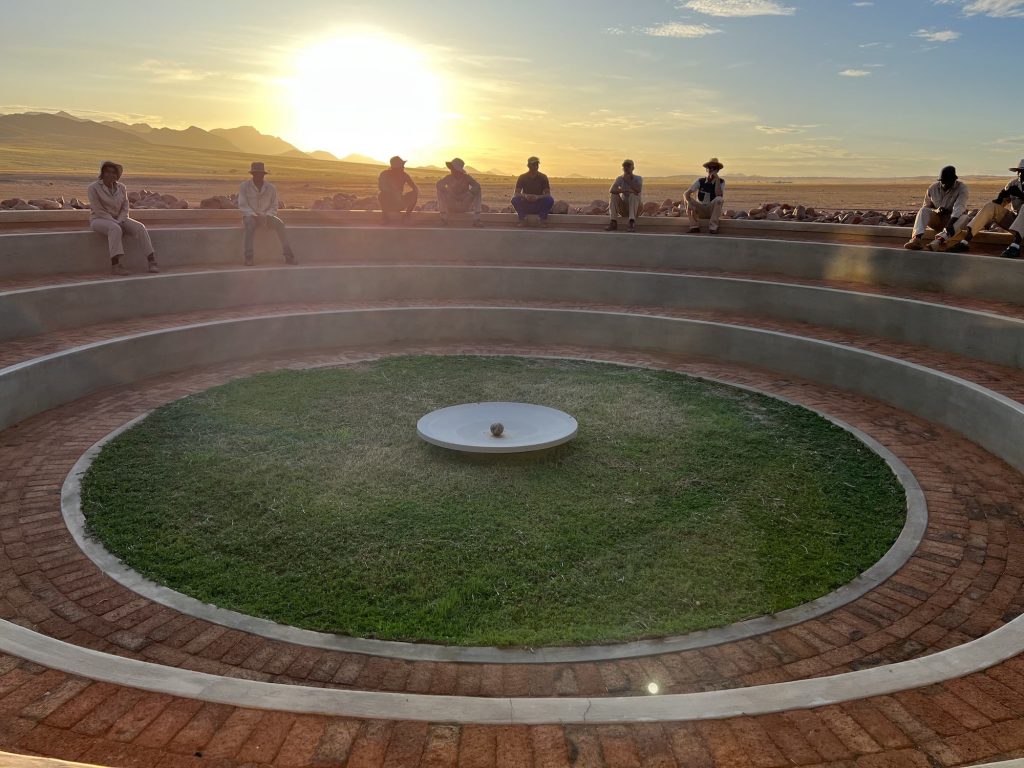
Desert time is morning time – it was boiling hot during the day. One morning – before circle time – we went out with the two ladies from the tourism business and walked to the mountain on the other side of the air strip and each of us created a rock circle, a routine of Stephan …. there is already a number of rock circles at the foothills. We would see zebras, springbock, Oryx from the distance. Another morning I went out with the ebike which looked like a moonbike and sometimes I simply would go for a walk. It’s nice to see the desert waking up!
After breakfast I would hang out at the staff canteen at the main plaza of the village trying to catch some WiFi. Communication is an issue at Wolwedans; the WiFi isn’t properly working, it’s very slow and the network coverage is rather bad. It certainly helps you to focus. I would talk to the staff and explore the various areas: the waste gallery, carpentry, the green house and the garden, the horses, pigs and chicken or the academy. Everything at Wolwedans is solar powered – there is no AC – even for the well-paying guests. The water, which is coming from wells, is harvested and re-used. Waste is strictly separated and waste manager Kaino is challenging all staff to go to the source whenever they can and think how to produce less waste at first hand. I saw Adrian working with the trainees in the gardens and checking the horse manure, and every now and then I ran into the tourism ladies. It’s a great atmosphere in the village – everyone is friendly and cooperative. In business language one would say they’ve a good culture (C=CULTURE). Not everything is perfect but they are working to become better every day.
I could sense how this place ticks – there is space for everyone and part of your job is to find your space. You’ve a lot of freedom to define it – that was beautiful to see. I could also see the links between Rural Revive and Wolwedans and almost everyone was aware of the projects.
Every day I’d have a couple of hours with Stephan – either over a drive throughout the property or a sundowner or dinner – he would share the latest news. “Weißt du …. ” (You know ….). Even though he had a lot on his plate, most of the time he was chilled and always made time for a conversation.
I was only there for a week, but at the end I felt I was there for much longer. If I would be younger, I said, I would apply for a job 🙂 The outcome for me was great, I got all that I wanted and even a bit more.
Stephan said that he was absolutely happy with the way everything worked out, he said I was present without being pushy, no signs of ego – I was simply part of the entire thing. I took this as a gret compliment. I left after we hugged each other.
I feel I’ve found a soulmate.
Another person who takes the struggle of making a difference serious.
What more do you want?
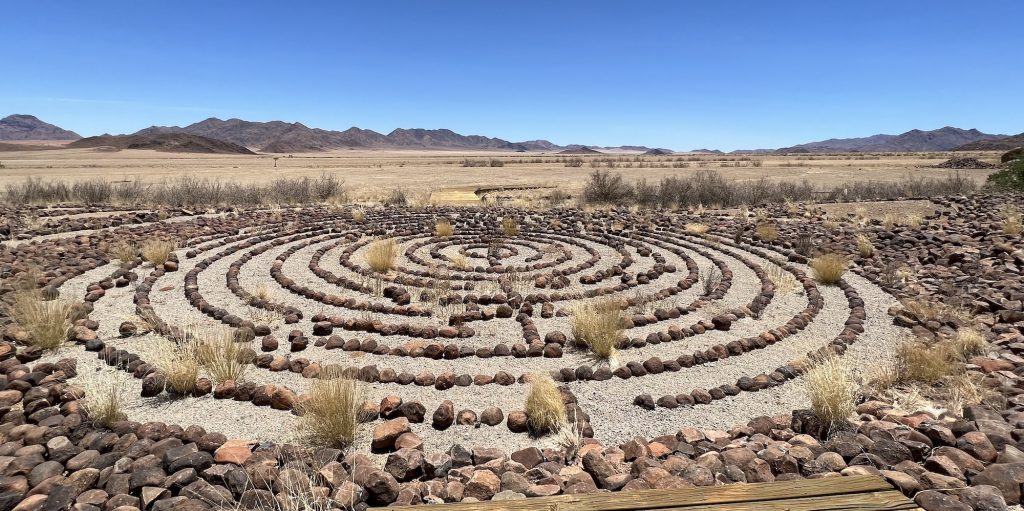
4 thoughts to “Where the Tar Road Ends …”
…Even though Ulrike writes, “…Remark: Just to be clear – the following essay (or however you want to call it) focuses on the development of the story, how I got the information I wanted – it is not an article on the topic which I mentioned above…” it IS already loaded with comprehensive information about the whole undertaking, and probably not much more could be absorbed by the reader in one article.
The whole essay (or however you want to call it) flows nicely and is sprinkled with little diamonds like “The second night I slept outside on the deck on one of the sunbeds – just to be literally under the stars. I “downloaded” the place. ” It makes you feel being there, too.
I had one question, though, regarding the process – how did the “non-interviews” take place? Ulrike’s answer: “Memorizing, evening >>> some notes.” I admire the dedication it takes to do so after a long day (and long dinner), but that for sure is really non-intrusive, and I think this way, one gets the best answers because the person you are talking to is not poised to deliver a “good interview”!
What an amazing story Ulrike! i know about the initiative and i am sure it is an amazing thing and it will work. we try a very similar approach at “We Do Special” but we are much smaller..but then, every drop counts 🙂 it is wonderful to hear that Stephan is paving the way and being a rolemodel, that means we are on the right way too. thanks to you Ulrike for this emotional and motivating insight!!!
Thanks Ulrike, what an honest and informative ‘behind-the-scenes’ essay. I wish more tourism journalists would write with your broad intake of information!
Thank you Leli, highly appreciated!